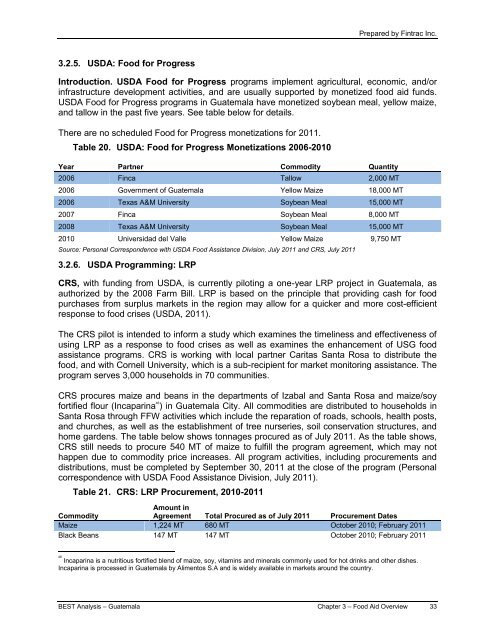usaid office of food for peace guatemala bellmon estimation
usaid office of food for peace guatemala bellmon estimation
usaid office of food for peace guatemala bellmon estimation
Create successful ePaper yourself
Turn your PDF publications into a flip-book with our unique Google optimized e-Paper software.
3.2.5. USDA: Food <strong>for</strong> Progress<br />
Prepared by Fintrac Inc.<br />
Introduction. USDA Food <strong>for</strong> Progress programs implement agricultural, economic, and/or<br />
infrastructure development activities, and are usually supported by monetized <strong>food</strong> aid funds.<br />
USDA Food <strong>for</strong> Progress programs in Guatemala have monetized soybean meal, yellow maize,<br />
and tallow in the past five years. See table below <strong>for</strong> details.<br />
There are no scheduled Food <strong>for</strong> Progress monetizations <strong>for</strong> 2011.<br />
Table 20. USDA: Food <strong>for</strong> Progress Monetizations 2006-2010<br />
Year Partner Commodity Quantity<br />
2006 Finca Tallow 2,000 MT<br />
2006 Government <strong>of</strong> Guatemala Yellow Maize 18,000 MT<br />
2006 Texas A&M University Soybean Meal 15,000 MT<br />
2007 Finca Soybean Meal 8,000 MT<br />
2008 Texas A&M University Soybean Meal 15,000 MT<br />
2010 Universidad del Valle Yellow Maize 9,750 MT<br />
Source: Personal Correspondence with USDA Food Assistance Division, July 2011 and CRS, July 2011<br />
3.2.6. USDA Programming: LRP<br />
CRS, with funding from USDA, is currently piloting a one-year LRP project in Guatemala, as<br />
authorized by the 2008 Farm Bill. LRP is based on the principle that providing cash <strong>for</strong> <strong>food</strong><br />
purchases from surplus markets in the region may allow <strong>for</strong> a quicker and more cost-efficient<br />
response to <strong>food</strong> crises (USDA, 2011).<br />
The CRS pilot is intended to in<strong>for</strong>m a study which examines the timeliness and effectiveness <strong>of</strong><br />
using LRP as a response to <strong>food</strong> crises as well as examines the enhancement <strong>of</strong> USG <strong>food</strong><br />
assistance programs. CRS is working with local partner Caritas Santa Rosa to distribute the<br />
<strong>food</strong>, and with Cornell University, which is a sub-recipient <strong>for</strong> market monitoring assistance. The<br />
program serves 3,000 households in 70 communities.<br />
CRS procures maize and beans in the departments <strong>of</strong> Izabal and Santa Rosa and maize/soy<br />
<strong>for</strong>tified flour (Incaparina 46<br />
) in Guatemala City. All commodities are distributed to households in<br />
Santa Rosa through FFW activities which include the reparation <strong>of</strong> roads, schools, health posts,<br />
and churches, as well as the establishment <strong>of</strong> tree nurseries, soil conservation structures, and<br />
home gardens. The table below shows tonnages procured as <strong>of</strong> July 2011. As the table shows,<br />
CRS still needs to procure 540 MT <strong>of</strong> maize to fulfill the program agreement, which may not<br />
happen due to commodity price increases. All program activities, including procurements and<br />
distributions, must be completed by September 30, 2011 at the close <strong>of</strong> the program (Personal<br />
correspondence with USDA Food Assistance Division, July 2011).<br />
Table 21. CRS: LRP Procurement, 2010-2011<br />
Commodity<br />
Amount in<br />
Agreement Total Procured as <strong>of</strong> July 2011 Procurement Dates<br />
Maize 1,224 MT 680 MT October 2010; February 2011<br />
Black Beans 147 MT 147 MT October 2010; February 2011<br />
46<br />
Incaparina is a nutritious <strong>for</strong>tified blend <strong>of</strong> maize, soy, vitamins and minerals commonly used <strong>for</strong> hot drinks and other dishes.<br />
Incaparina is processed in Guatemala by Alimentos S.A and is widely available in markets around the country.<br />
BEST Analysis – Guatemala Chapter 3 – Food Aid Overview 33

















